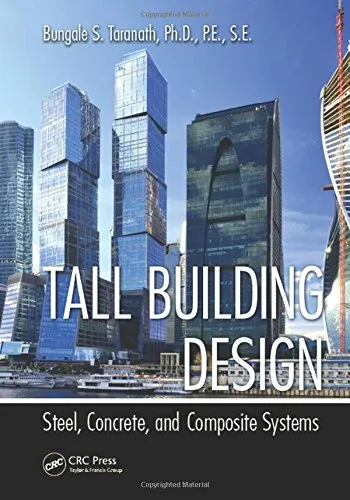Tall building design: steel, concrete, and composite systems
4.6
بر اساس نظر کاربران

شما میتونید سوالاتتون در باره کتاب رو از هوش مصنوعیش بعد از ورود بپرسید
هر دانلود یا پرسش از هوش مصنوعی 2 امتیاز لازم دارد، برای بدست آوردن امتیاز رایگان، به صفحه ی راهنمای امتیازات سر بزنید و یک سری کار ارزشمند انجام بدینکتاب های مرتبط:
معرفی جامع کتاب "Tall Building Design: Steel, Concrete, and Composite Systems"
کتاب "Tall Building Design: Steel, Concrete, and Composite Systems" نوشته بانگل اس. تارانات یکی از جامعترین و برجستهترین منابع موجود در حوزه طراحی ساختمانهای بلند است. این کتاب با رویکردی عملی و تخصصی، اصول مهندسی و روشهای طراحی را برای سیستمهای فولادی، بتنی و ترکیبی (Composite Systems) تشریح میکند. در ادامه بخشهای مختلف کتاب معرفی شده و اهمیت آن توضیح داده میشود.
خلاصهای از محتوای کتاب
کتاب حاضر به طور تخصصی به بررسی مبانی نظری و اجرایی طراحی ساختمانهای بلند میپردازد. این اثر نه تنها اصول پایهای و مفاهیم اصلی مهندسی سازه را برای سیستمهای فولادی، بتنی، و ترکیبی پوشش میدهد، بلکه از مطالعههای موردی (Case Studies) واقعی بهره میگیرد تا مهارتهای عملی خوانندگان را گسترش دهد. ساختار کتاب به گونهای است که هم برای مهندسان تازهکار و هم برای متخصصان باتجربه در زمینه طراحی ساختمانهای بلند مناسب باشد.
فصلهای اولیه این کتاب مقدمهای بر مفاهیم اساسی نظیر بارگذاری، تحلیل، و عملکرد سیستمی ساختمانهای بلند فراهم میآورند. سپس با جزئیات بیشتری وارد موضوعات پیشرفتهای مانند تحلیل لرزهای، طراحی در برابر باد، و رفتار غیرخطی میشود. روشهای طراحی با استفاده از Steel Systems، Concrete Systems، و Composite Systems به طور جداگانه بررسی شده و بهترین راهکارهای ترکیبی پیشنهاد شدهاند.
نکات کلیدی کتاب
- تمرکز بر سیستمهای باری مختلف شامل سیستمهای فولادی، بتنی و ترکیبی
- معرفی آخرین متدهای طراحی و تکنیکهای تحلیل لرزهای
- مطالعههای واقعی از پروژههای موفق ساختمانی
- بررسی روشهای کاهش مصرف مصالح و بهینهسازی انرژی
- تمرکز بر استانداردهای بینالمللی طراحی نظیر AISC و ACI
جملات معروف از کتاب
"در طراحی ساختمانهای بلند، رسیدن به تعادل میان نوآوری، پایداری و اقتصادی بودن، هنر واقعی هر مهندسی است."
"سیستمهای Composite، پلی میان قدرت فولاد و انعطافپذیری بتن ایجاد میکنند تا ساختمانها قدرتمندتر و کارآمدتر شوند."
"طراحی ساختمانهای بلند، نیازمند نگرش جامع به اهداف سازهای، زیباییشناسی معماری، و الزامات محیطی است."
چرا این کتاب اهمیت دارد؟
کتاب "Tall Building Design: Steel, Concrete, and Composite Systems" به دلایل متعددی یکی از برجستهترین منابع علمی در حوزه طراحی ساختمانهای بلند به شمار میرود. اولاً، این کتاب به بررسی جامع اصول طراحی و مفاهیم کاربردی میپردازد و برای مهندسین، معماران و دانشجویان علاقهمند مناسب است. ثانیاً، تمرکز کتاب بر تطبیق تئوری با عمل و ارائه نمونههای واقعی از پروژههای ساختمانی، توانایی خوانندگان را در حل مشکلات عملی افزایش میدهد. ثالثاً، وجود محتوای تخصصی در زمینه رفتار سیستمهای Composite و بررسی تفاوتها و مزایای این سیستم با دیگر سیستمها، به اهمیت کتاب میافزاید.
علاوه بر این، کتاب به دلیل رویکرد بینالمللی خود و استفاده از استانداردهای شناختهشده در دنیا، به عنوان راهنمایی معتبر برای طراحی ساختمانهای بلند در هر نقطه از جهان شناخته میشود. با توجه به رشد روزافزون شهرهای بزرگ و نیاز به ساخت ساختمانهایی ایمن و پایدار، این کتاب به ابزاری حیاتی برای مهندسان و طراحان تبدیل شده است.
Introduction to "Tall Building Design: Steel, Concrete, and Composite Systems"
"Tall Building Design: Steel, Concrete, and Composite Systems" is a comprehensive guide that bridges the gap between architectural vision and engineering feasibility. Authored by Bungale S. Taranath, this book offers an in-depth understanding of the structural and material requirements crucial to the design and construction of tall buildings. It is an indispensable resource for architects, structural engineers, and construction professionals striving to master modern high-rise construction technologies.
Focusing on both fundamental principles and advanced design concepts, the book intricately explains the use of steel, concrete, and composite materials in crafting iconic skyscrapers. By addressing real-world challenges and incorporating insights gained from practical experience, the book provides innovative solutions to optimize a building's performance, efficiency, and safety. Rich in technical expertise and industry insights, it is a definitive guide for tackling the unique engineering demands of today’s tall structures.
A Detailed Summary of the Book
Comprising critical knowledge on tall building design, this book systematically covers various materials and technologies utilized in constructing high-rise structures.
The book starts with an exploration of the fundamental principles of structural engineering, including a comprehensive discussion of load calculations, lateral systems, and foundational design methodologies. These concepts lay the groundwork for an understanding of how tall buildings are supported and stabilized against natural forces like wind and seismic events. Taranath thoroughly explains how to achieve balance between structural integrity, economic feasibility, and architectural requirements.
Breaking the material-specific aspects into three distinct sections—steel systems, concrete systems, and composite systems—the book offers an in-depth analysis of each category. Readers will find detailed explanations of modern construction practices, material design formulas, and case studies showcasing successful applications of these systems around the world. Additionally, the role of innovative technologies such as dampers, outriggers, and core-wall systems is explored in detail.
Equipped with cutting-edge examples, advanced computational models, and illustrations, the book is not only a theoretical guide but also a practical toolkit for implementing efficient design strategies in the construction of skyscrapers.
Key Takeaways
- A clear understanding of different structural systems (steel, concrete, and composite) for tall buildings.
- In-depth knowledge of load distribution, lateral stability, and resistance to seismic and wind forces.
- Practical strategies for optimizing design costs while maintaining maximum structural efficiency.
- Insights into modern advancements, including material innovations and analytical modeling techniques.
- Case studies that highlight the best practices in tall building design worldwide.
Famous Quotes from the Book
The book is packed with valuable insights, but a few quotes stand out for their wisdom and relevance:
"Engineering is the art of negotiation between material efficiency, structural performance, and architectural aesthetics."
"Tall buildings are a testament to the collaboration of science and creativity, achieving feats that once existed only in dreams."
"The true measure of a skyscraper’s success is how it harmonizes practicality with ambition."
Why This Book Matters
The importance of this book cannot be overstated, given the growing global demand for urban vertical expansion.
As cities become increasingly crowded, tall buildings have become the cornerstone of modern urban planning. However, constructing and designing high-rise structures requires a fine balance between engineering expertise and architectural innovation. This book fills the critical knowledge gap by providing everyone—from students to seasoned professionals—with the tools necessary to design safe, economical, and visually impactful high-rises.
Moreover, the book delves deeply into global trends and challenges in high-rise construction, inspiring practitioners to adopt environmentally sustainable and energy-efficient approaches. It not only conveys technical mastery but also advocates for solving real-world issues with creativity, innovation, and responsibility.
In a rapidly urbanizing world, "Tall Building Design: Steel, Concrete, and Composite Systems" is more than a guide—it is a beacon for those aspiring to leave a lasting legacy on the skylines of tomorrow.
دانلود رایگان مستقیم
شما میتونید سوالاتتون در باره کتاب رو از هوش مصنوعیش بعد از ورود بپرسید
دسترسی به کتابها از طریق پلتفرمهای قانونی و کتابخانههای عمومی نه تنها از حقوق نویسندگان و ناشران حمایت میکند، بلکه به پایداری فرهنگ کتابخوانی نیز کمک میرساند. پیش از دانلود، لحظهای به بررسی این گزینهها فکر کنید.
این کتاب رو در پلتفرم های دیگه ببینید
WorldCat به شما کمک میکنه تا کتاب ها رو در کتابخانه های سراسر دنیا پیدا کنید
امتیازها، نظرات تخصصی و صحبت ها درباره کتاب را در Goodreads ببینید
کتابهای کمیاب یا دست دوم را در AbeBooks پیدا کنید و بخرید
1369
بازدید4.6
امتیاز0
نظر98%
رضایتنظرات:
4.6
بر اساس 0 نظر کاربران
Questions & Answers
Ask questions about this book or help others by answering
No questions yet. Be the first to ask!






![The Ultimate iOS Interview Playbook: Conquer Swift, frameworks, design patterns, and app architecture [Team-IRA]](https://s3.refhub.ir/images/thumb/The_Ultimate_iOS_Interview_Playbook__Conquer__29925.webp)







